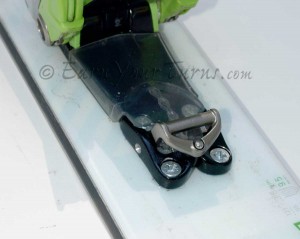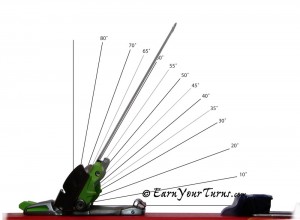After six years Black Diamond’s O1 will feature a six-hole mounting pattern. As with all other telemark bindings using a six-hole pattern, it doesn’t match any other binding on the market. That’s the bad news. The good news is the two extra holes extend the overall length, and thus the retention surface area of the mounting pattern. Though too early to tell for certain, this ought to eliminate the potential for O1’s to pull out of skis.
It had to have been an embarassing moment when a photo of Nick DeVore, a sponsored BD telemark athlete, made the rounds on the internet holding up his skis after a fall with the O1 binding torn from the ski. Though I’m willing to admit that the number of people who manage to do this is smaller than the amount of attention it attracts on the internet would indicate, nonetheless the tendency for O1’s to be pried from skis is more likely than bindings with a six hole pattern like the Axl or Hammerhead.
BD’s claim that mounting the O1 with less than perfect precision is the largest contributor to failure. While that may be true in some cases it simply failed to account for the reality that few bindings are ever mounted perfectly. The extension of the mounting plate and two additional mounting screws at the rear of the binding is bound to eliminate the problem of the O1 being pried loose from the ski, but it will take a few years for awareness of the fix to filter into the consciousness of the average pinhead.

The 2 new mounting screws are added at the rear where all the forces to peel the binding from a ski are concentrated.
Changing springs is still a tedious operation, but one that is rarely done. If you’re using a lower cuffed, 3-buckle boot the mid-stiff cartridges will probably work well, and for beefy, 4-buckle boots the ridiculously-stiff cartridges are the popular choice.
Range of motion in tour mode is still a healthy 60° plus and yes, ice occasionally builds up on the underbelly of the toe plate which frustrates switching back to turn mode. It doesn’t happen too often, much less than an Ascent, but a lot more than a Switchback.For those who want a full featured tele binding, BD’s O1 is one of the few that offers an optional ski crampon that fits between your boot and the spring cartridges. Thus it lifts with your foot to reduce friction when striding forward, but bites into the snow as your heel comes down.
Black Diamond’s improved O1 with a new, 6-hole mounting pattern still provides an excellent mix of functionality for telemark mountaineers. The mode switch is easy to operate, tour mode provides a huge range of unrestricted motion, and a pair of under-foot routed spring cartridges deliver more than enough power to control any ski you pair them with. If you’re still using a simple cable binding, you won’t regret upgrading to the Oh-one one iota.Black Diamond
O1
MSRP: $300
Weight: 3 lbs., 12 oz.
Related Posts
BD’s O1 (2011)
BD Introduces O1 (2006)
© 2012




3 comments
3 pings
Not sure if that will work in preventing the binding from breaking. If anything, the power/energy will be transferred to the ski, which will break. The mountains are littered with broken skis pushed behind their design by over aggressive skiers. (or over-weight!).
My concern with the O1 has more to do with pivot fatigue and the wobble that develops. Hopefully they worked on that. I have been through 4 pairs of these bindings, when I should have only needed maybe 2 due to the wobble issue.
According to the engineers at BD, the biggest factor in a reliable mounting is the amount of torque that is used to seat the screw, and thus, hold it in the ski. Too little and it eventually comes loose and rips out. It’s a variation of the 2nd Law of Thermodynamics which goes thusly – screws never get tighter, they only loosen over time. The exception is steel bolts that rust in place, but that’s still just a variation of the same Law. 😉
The pull out is due to insufficient binding travel, so adding screws will delay the pull out, but it won’t eliminate it. I had this same problem with Burnt Mount bindings until the longer spring tubes evolved. If the load weren’t quite so dynamic, we could get by with AT mounting, but telemark really loads the mounting.
[…] Not much new in tele. Axl is mature and solid, so are the Switchback brothers, and BD’s O1. All decent choices and now joined by G3′s Enzo which lived up to my expectations of shedding […]
[…] […]
[…] ne hanno 6 Modello 2011/12 4 fori, modello 2012/13 6 fori. 2 Link utili riguardo l'argomento Telemark binding review: Black Diamond's O1 | EarnYourTurns The Holy Grail: How to keep BD 01's from ripping out Insomma pare di capire che puo' succedere […]